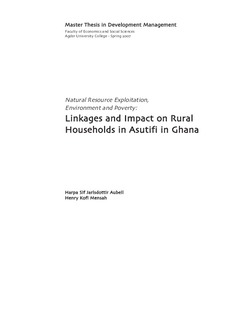| dc.description.abstract | The controversial negative relationship between the abundance of natural resources and
economic growth and development has been at the centre of several development
research discourses. It is often explained that, natural resources when exploited can be
used to generate economic growth and development. However, this assertion is often
rebuffed by other explanations that, natural resource abundance rather create more
difficulties than benefits. The abundance of oil, coal, gold and even trees have been the
route cause of problems such as riots, wars, corruption, inflation, environmental
degradation and reduced economic growth in many resource rich nations especially
within Sub-Sahara Africa.
Governments in developing countries with large amounts of resource have pursued
policies that seek to expand the exploitation of existing natural resources to generate
income for economic development. Over the years not much attention has been paid to
the negative effects of policies that centre on the exploitation of natural as the main tool
for economic growth and development. Natural resource exploitation has proven of
potentially causing irreparable distortion on the environment and the livelihood of the
people in the affected communities.
This research attempts to make an investigation into the linkages between natural
resource exploitation, environmental degradation and poverty, and the impact that natural
resource exploitation has on the livelihood of rural households. Using Ghana’s gold
mining sector as a case study, this research brings new evidence more precisely the area
of Asutifi, on the linkages between mining, environmental degradation and poverty.
Employing the Sustainable Livelihood Approach as an analytical tool, this demonstrates
the negative relationship that exists between the abundance of natural resources and
economic growth and development. This is done by assessing the impacts of natural
resource exploitation on the rural households with help of the Sustainable Livelihood
Framework showing examples of how the exploitation can lead to poverty.
The first chapter of this paper is devoted for a general introduction to the phenomenon of
natural resource exploitation and its linkages with environmental degradation and
poverty. It also set out the problem to be investigated and outlines the objectives of the
study. This is followed by the literature review chapter which reviews literature from the
national and international mainstreams on themes such as; natural resource abundance
and economic growth/development, resource exploitation, environmental degradation and
poverty; natural resources and sustainable livelihood among other related mainstreams
and theories.
The third chapter of this study gives an overview of the extractive sector of Ghana’s
economy and a brief description of the study area. It reviews the growth and expansion in
Ghana’s mining industry and its contributions to the growth of the economy in general.
The regulatory environment in the mining sector and the impact it has on the social and
physical environment is also discussed here.
iii
The theoretical basis of this study is introduced in the fourth chapter. The chapter tries to
explain the sustainable livelihood approach which was conceptualized by the UK
Department for International Development (DFID). This Approach is widely used in
development research and thus was considered the most appropriate for analyzing the
interface between natural resource exploitation and the creation of new poverty or
poverty exacerbation
The fifth chapter explains the methodological approach for this study. It also reviews
some existing methodological approaches and discusses the choice of research methods
for this study. It also explains the analysis procedures used and the process by which the
data collection was conducted.
This study’s findings are presented and discussed in the sixth chapter. In this chapter the
study uses the sustainable livelihood framework, to assess to what extent mining has
distorted the livelihood systems in the study area. It also uses some aspects of Mining-
Induced Displacement and Resettlement Model.
In the end, this all sums up to conclude, that the impacts of mineral resources exploitation
on rural households in mining communities in the Asutifi District of Ghana have so far
been negative, socially, economically, health-wise and environmentally. It recommends
that government and all stakeholders in the mining sector should come together to device
strategies on how to make mining operations contribute positively to community
development rather than negatively. As the situation is today, evident support that natural
resource exploitation is much more a case of poverty exacerbation than sustainable
development. | en |
